The 10 Second Pre-Shoot Camera Check

I'll be the first to admit that I've ruined shots because I failed to check my camera settings before shooting. Haven't most of us been in that situation? You're shooting something out of the norm (maybe some manual controls, exposure compensations, ISO settings, etc), and you don't set your camera back to the “regular” settings. So you pick up the camera again after a few days and start shooting, only to realize that you completely screwed up a bunch of shots because the camera was still set for that last outing.
After doing this a few times, I've gotten in the habit of spending 10 or 15 seconds checking my camera settings before I shoot. Of course, all cameras are different (as are shooting styles), so this is just my own personal checklist of things I look at. Yours may be different, but the point is that you should have that habit of checking the settings prior to releasing the shutter. Here's a rundown of what I look at and how I typically set my camera.
1. PRIORITY MODE
My usual setting is aperture priority mode, but I'll sometimes switch to shutter priority or full manual. I always make a note to set it back to aperture priority before I start shooting, unless the situation calls for something different.
2. SHUTTER / F-NUMBER
This one varies on the lens attached, but I usually preset my 50mm lens at f/2 or f/2.4 while in aperture priority mode. The reason I do this is because I know that's fast enough for most lighting situations, and it reflects my personal shooting preferences (I like somewhat shallow DOF most of the time).
3. EXPOSURE COMPENSATION
For me, this setting usually stays at zero, but sometimes I'll move it around in difficult lighting situations. This one is a big deal — I've been burned more than once because I didn't set it back to zero. If your compensation is way off, you can't recover a bad shot.
4. ISO SPEED
My usual ISO setting is “auto” — and my auto is allowed to vary between 200 and 1600. In bright situations, I'll set it to 100. And in dark situations, I'll set it to 3200 or 6400. I always check that I set it back to auto-ISO so I don't go out in full afternoon sun shooting at ISO 3200.
5. DRIVE MODE
Most of the time, I'll leave my drive mode on machine gun mode (or hi-continuous). I don't use it very often, but it's nice to have it ready if I do need it (sucks when you need it and it's turned off). On occasion, I'll switch over to single shot if I keep firing too many accidental continuous shots.
6. AUTOFOCUS MODE / AREA
For the most part, I like to keep my camera in AF-S (single shot) mode. I find that continuous AF and auto AF slow down my continuous drive when I do need it, and Manual focus is rarely used on my digital camera.
7. METER MODE
I've grown to like spot metering, and I rarely change it from that. If I do, I try to make sure to set it back to spot so that my exposures are closer to what I expect.
8. COLOR SPACE
I don't think I've ever changed this setting, but I glance over it to make sure I didn't change it by accident last time out.
9. WHITE BALANCE
Another setting that I rarely change. Auto white balance usually does an OK job (except for incandescent lighting), and it doesn't really matter much when shooting in a Raw format.
10. BATTERY POWER
Although this item is near the bottom of my screen and the bottom of my list, it's probably the most important. ALWAYS check your batter power before you even walk out the door. I messed this up just once… haven't done it again.
11. FILE FORMAT
Yet another setting that I rarely change, but a good one to double check. I'd be kinda pissed if I spent a whole day shooting only to realize that I shot all JPEG images rather than Raw.
12. REMAINING SHOTS
I usually have the same memory card in the camera and I know that I can get a bit over 400 shots on my card. So if I see less than 400 available photos, I know that I need to format the card and clear out the old photos.
Again, these are just the things I quickly glance over before shooting. Other cameras and other photographers will have different needs and different checklists. But the point is that you should have some sort of camera setting checklist burned into your mind.
What other things do you check before shooting? And what are your typical settings for some of these items?